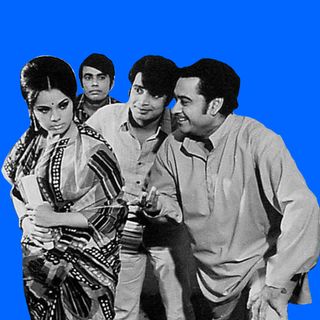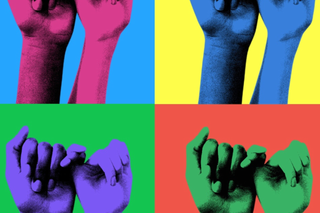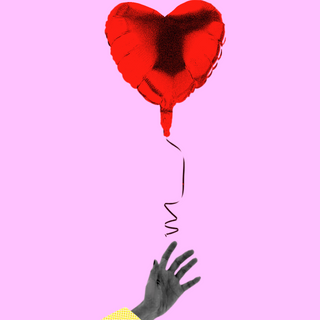
Psyched Up: We’re Probably Getting Attachment Styles All Wrong
Unlike what Instagram suggests, the attachment theory isn’t a way to diagnose potential – or failing – relationships. Or people.

In 'Psyched Up', we find out what’s wrong with the pop psychology fads we love.
A woman sits by a shuttered window, nervously checking her phone. Pausing briefly, she peeks out to look for a car that should have pulled up in the driveway by now, but hasn’t. The rest of the video is a rapid-fire account of the internal turmoil she’s experiencing – anxiety, worry, fear, and panic – all of which would quickly dissipate if only a text or call came through. This is apparently what an anxious attachment style feels like, according to a 15-second Instagram reel. Another reel goes one step further to depict an anxious attacher driving by her partner’s house to check if he’s cheating on her – a spiral initiated by the lack of a good morning text from him. Sure, it’s exaggerated (the therapist who posted it says as much in the caption), but it’s designed to be relatable, like most Instagram content on the attachment theory.
Whether you are the “anxious” attacher with a fear of abandonment, the distant “avoidant,” the rare “disorganized” combination of the two, or the trusting and confident “secure,” there’s a relationship coach, social media therapist, or at least a meme for you. This is what happens when a psychology framework meets the TikTokification of relationship advice. You get a flurry of bite-sized posts primed to go viral, a framework whittled down to sweeping diagnostic labels, and the idea that the secret to a great relationship lies in answering a single question: “What is your attachment style?”
The theory itself can be useful as a lens through which to confront old behavioral patterns, gain a deeper understanding of oneself and learn new ways to connect with a partner whose behavioral patterns conflict with your own. There’s a large body of research that supports the framework, countless testimonies by people who have applied it in their lives and a number of therapists continue to use it in their work. Social media, however, strips this theory of its nuances. For instance, a subset of posts are quick to conflate micro-behaviors as symptomatic of certain attachment styles: Not answering a text on time may be dubbed as avoidant behavior and sending a bunch of texts in a row may earn you the label of an anxious attacher. If you’re a “lone wolf,” you’re avoidant; if you’re uncomfortable being alone, you’re an anxious attacher. The contentification of psychology is leading to people diagnosing their relationships in a matter of seconds and interpreting these styles as personality-defining labels.
As is often the case with pop psychology, the mainstreaming of this theory took off with the publication of a bestselling title: Attached: The New Science of Adult Attachment and How It Can Help You Find — and Keep — Love, the 2010 book by Dr. Amir Levine and Rachel Heller. In 2021, the book’s sales skyrocketed again (possibly spurred on by the isolation brought on by Covid19 lockdowns), according to The New York Times. This time, it was aided by TikTok, where #AttachmentStyle quickly became a trending hashtag. But this book, which turned into a relationship self-help cornerstone, had its problems: “Its view toward intimacy issues is often tilted at finding partners who suit one’s own attachment style — either one that matches, or someone with a secure attachment style — rather than mending relationships between two conflicting attachment styles, which the book dedicates some real estate to, but not a ton,” noted the NYT article. In other words, we’re looking at people as a set of attributes, not as complex individuals with their own interiority.
With the popularization of the attachment theory, a new language emerged – one so pervasive that we now apply this terminology to make sense of relationships not only in real life but also in fiction. Take the case of a licensed therapist who applied this framework to “diagnose” pop culture’s favorite dysfunctional family, the Roys from HBO’s “Succession.” Anybody familiar with the Roys may find themselves nodding along in agreement when she suggests that both Kendall and Roman Roy are “anxious-preoccupied,” Shiv is “disorganized,” while the patriarch himself, Logan, is “dismissive-avoidant.”
Social media posts on the attachment theory serve up a constant reminder that our parents may have a much larger role to play in shaping the fate of our relationships than we may know. And that is because this framework that has become the hallmark of modern dating originated as a theory to explain babies’ attachment to their caregivers.
In the 1950s, psychoanalyst John Bowlby suggested that babies have an innate ability to attach to their caregivers and that these bonds formed in the early years of life influence how secure or insecure people are in future relationships. Bowlby, along with psychoanalyst Mary Ainsworth, created the three main attachment styles to describe how babies reacted to their caregivers after being separated and then reunited with them. It was only in 1987 that social psychologists Cindy Hazan and Phil Shaver first applied this theory to romantic relationships. Soon, the language of attachment styles was being spoken by not only psychologists and researchers but also parents, child welfare experts and, now, romantic partners. But Bowlby’s theory that began it all was later criticized for focusing much too heavily on a single factor – the mother’s caregiving role – while ignoring the role of social inequality, the larger environment, or even future relationships with others. Notably, the theory also emerged in America at a time when fears were widespread about women going to work post the Second World War, according to an article in Fatherly.
Several experts have therefore expressed concern that people may be identifying much too strongly with these “types,” which in reality are not meant to be rigid categories but a spectrum. Research now shows these styles evolve over time, and an individual can have one attachment style with their romantic partner, and another with their friends, colleagues, or parents. The attachment styles are “a working model that varies in the extent to which you are avoidant or anxiously attached… It’s not categorical in a way that we oftentimes want to say things are in pop psych settings,” said Grace Vieth, a PhD student at the Social Interaction Lab at the University of Minnesota.
But influencers on social media – including those who aren’t qualified therapists – continue to lay out the signs and behavioral patterns of particular styles, with some decoding where these behaviors might be stemming from. Any framework when turned into content bears the risk of being misinterpreted. Without a professional’s guidance, people may be quick to box other complex, unpredictable humans into categories, assign value judgments to specific styles, and even draw assumptions about their past. Here’s one that provides a checklist to prove someone is dating an avoidant: “manchild behavior,” “cold,” “love bombing” but quickly leaves when vulnerability is involved; in sum, someone who “loves control.” Inevitably, the end result is that a large subset of the population may be pathologizing themselves and others – often negatively – based on a few seconds’ worth of content or five-minute quizzes. In this way, the attachment theory is being used like personality tests, which have long been seen as pseudoscience and repeatedly debunked for lacking evidence. Turning information about one’s attachment style into a label thus misleads people into believing that these categorizations are inherent, unchangeable aspects of one’s personality.
“Labeling someone to a single attachment style creates a distorted view of that individual that does not account for the lived experiences, beliefs, or even values,” said Omar Ruiz, a licensed marriage therapist. Attaching names to behaviors also generates the issue of what philosopher Ian Hacking called “looping effects,” where if one strongly identifies with a label, they may begin altering their behavior to fit that label.
It’s easy to see why this theory is so appealing today; in a world riddled with uncertainties, it makes other humans predictable. It offers a window into what a relationship with another person would look like, sans the time and emotional investment that could possibly end in heartbreak. The downside to embracing the theory the way we currently are, as some experts are pointing out, is that too many are employing it to filter people out.
Gen Z, for instance, are actively looking for the “right attachment style,” one report suggests. If there’s a "right" style, there must be a wrong one, and that (dis)honor often goes to the three styles clubbed under “insecure” or “unhealthy” attachment styles. A distinct hierarchy is created that does little to address the communication gaps and trust barriers that can exist in any relationship. Instead, it can quickly spiral into demonizing a specific attachment style you’ve had a bad experience with, and perpetuate the false idea that some attachment style pairings just don’t work. “When I realize all the time I wasted … dating avoidant, emotionally unavailable people who were practically designed to make my anxiety continue…” says one woman in a reel.
The attachment theory on the Internet is thus feeding into the ever-increasing solipsism with which we’ve begun to interpret the world. It’s a tinderbox for main character syndrome: other people are assessed as per their usefulness to oneself, as opposed to being viewed as inherently valuable on their own.
Granted, there are enough creators who are attempting to bring back the nuances that were lost when this theory was first distilled into nuggets of information for a chronically online audience. But at first glance, what comes across on social media is this: Attachment styles are static (they’re not); your attachment pattern defines the way you behave in relationships (it’s not the only thing that does); some attachment styles may just be better than others (the anxious versus avoidant camps on the internet are quick to remind us of this). It is this endless stream of highly-relatable content that, in promising to make us more self-aware, indirectly ends up encouraging us to "optimize" our relationships like we might our jobs. Personal boundaries, values, and red flags we may recognize from past experiences are undoubtedly important to pay attention to. But in shutting ourselves off from those who don’t tick the "right" boxes delivered to us as Instagram checklists, we’re no longer cultivating accountability. Instead, we may have veered into territory where our unwillingness to interact with others based on labels or micro-behaviors that we interpret as signs of future incompatibility is only eroding human empathy.
As Eleanor Morgan, a trainee psychotherapist, told Refinery 29, "If attachment theory can be a gateway into deeper work with a therapist or individual research, great... If not – if we’re using Instagram posts alone to label and diagnose our partners – and that’s a slippery path to losing some empathy." The current discourse online may be breeding an overreliance on attachment styles – a framework that is only one explanation among many – to explain all aspects of someone’s behavior. The attachment theory is not a silver bullet to all relationship problems. There is none.
The rapid spread of attachment styles is arguably a symptom of a larger churn: the alienation of modern societies. The need to categorize, sort, label, and define is an instinct that may have been exacerbated by the growing uncertainties around us, spurring a search for maximum security in relationships with little to no conflict. But knowing one’s attachment style is not a quick fix – the solution, in part, may lie in the work that comes after, under the guidance of an expert. It’s recognizing that one’s ability to improve connection is not governed by any attachment style, that sometimes an unanswered text may be just that, and that absolute labels cannot possibly encompass the whole range of experiences and emotions that make up human beings.
Ananya Singh is a Senior Staff Writer at TheSwaddle. She has previously worked as a journalist, researcher and copy editor. Her work explores the intersection of environment, gender and health, with a focus on social and climate justice.
Related


Falling Out of Love Isn’t a Bad Thing
